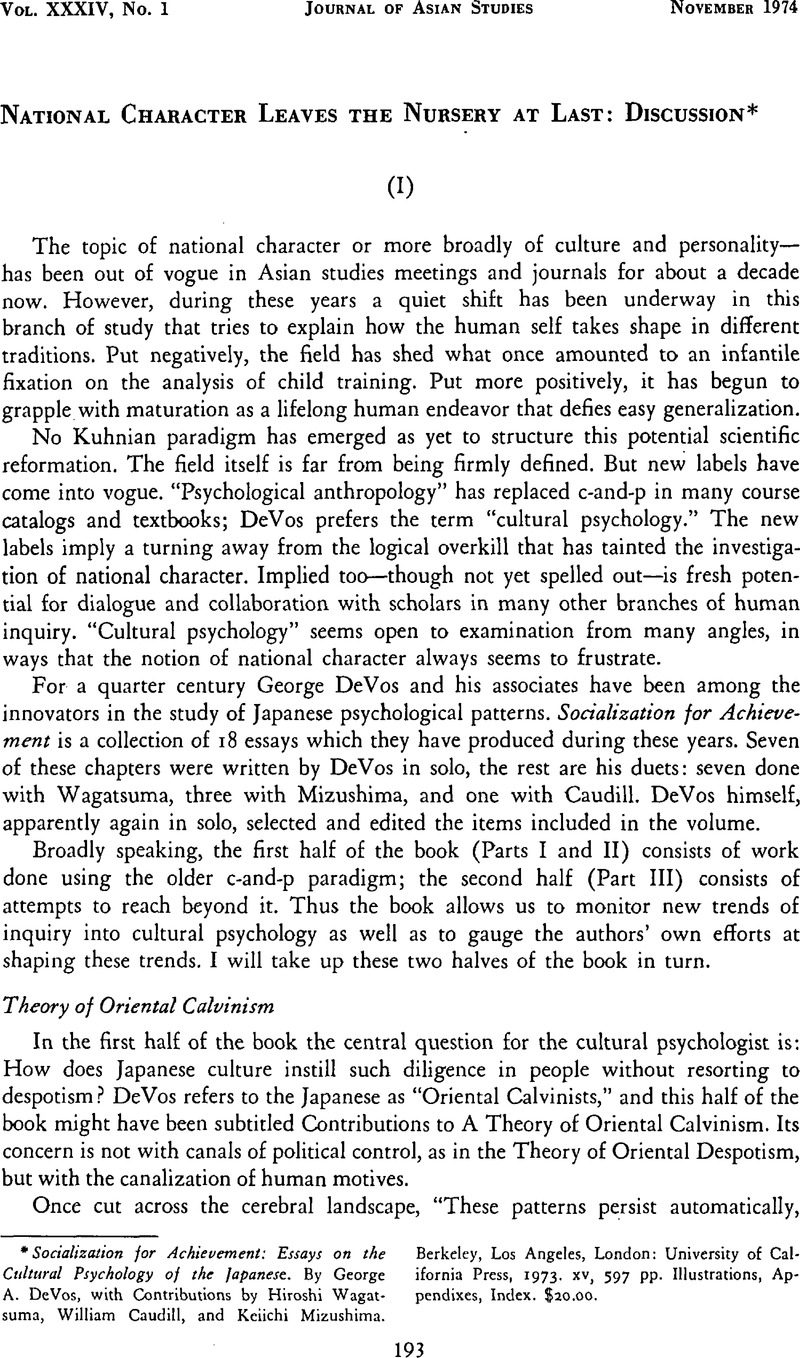No CrossRef data available.
Article contents
National Character Leaves the Nursery at Last: Discussion*
Published online by Cambridge University Press: 23 March 2011
Abstract

- Type
- Review Articles
- Information
- Copyright
- Copyright © The Association for Asian Studies, Inc. 1974
Footnotes
Socialization for Achievement: Essays on the Cultural Psychology of the Japanese. By George A. DeVos, with Contributions by Hiroshi Wagatsuma, William Caudill, and Keiichi Mizushima. Berkeley, Los Angeles, London: University of California Press, 1973. xv, 597 pp. Illustrations, Appendixes, Index. $20.00.
References
1 Lebra, Takie S., “Compensative justice and moral investment among Japanese, Chinese and Koreans,” journal of Nervous and Mental Disease, Vol. 157, No. 4 (October, 1973), pp. 278–291.CrossRefGoogle ScholarPubMed
2 Haak, Ronald O., Nishijin Weavers: A Study oj the Functions of Tradition in Modern japan (unpublished PhD dissertation, University of 11linois, Urbana-Champaign, 1973).Google Scholar
3 For a recent review and critique of culture-and-personality studies on Japan see relevant sections of Edward Norbeck and Susan Parman (eds.), The Study of Japan in the Behavioral Sciences (Rice University Studies, Vol. 56, No. 4, 1970).Google Scholar
4 Caudill, William A., “The influence of social structure and culture on human behavior in mod-ern Japan,” Journal of Nervous and Mental Disease, Vol. 157, No. 4 (October, 1973) pp. 240–257.CrossRefGoogle Scholar
5 Lifton, Robert J., “Youth and history: individual change in postwar Japan,” in Erikson, Erik (ed.), The Challenge of Youth (Anchor Books A438, 1963) pp. 260”290.Google Scholar
6 On personal change in marriage, see for exampie Sonya Salamon, “Male chauvinism as a manifestation of love in Japanese marriages,” paper given at annual meetings of the American AnCenturythropological Assn., New Orleans, November, 1973. On socialization into a large corporation, see Thomas, Rohlen, For Harmony and Strength: Jap-anese White Collar Organization in Anthropologi-cal Perspective (Berkeley, Los Angeles, London: University of California Press, 1974).Google Scholar And on ideological conversions, see among others Chapter I of Tsurumi, Kazuko, Social Change and the Individual: Japan Before and After World War U (Princeton: Princeton University Press, 1970).Google Scholar
7 Sparks, Douglas E., “The still rebirth: role discontinuity and retirement in Japan,” paper given at annual meetings of the American Anthropological Assn., New Orleans, November, 1973.Google Scholar Plath, David W., “Japan: the after years,” in Cowgill, Donald and Holmes, Lowell (eds.), Aging and Modernization (New York: Appleton-Century Crofts, 1972), pp. 133–150.Google Scholar
8 See the discussions by Kano Tsutomu and Minami Hiroshi, The Japan Interpreter Vol. 8, No. 2 (spring, 1973), pp. 153–175.Google Scholar


